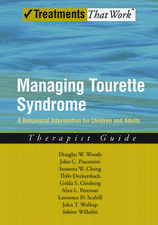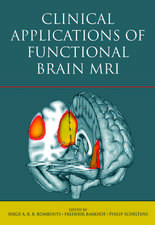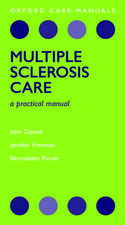Hormones and Brain Plasticity: Oxford Series in Behavioral Neuroendocrinology
Autor Luis Miguel García-Seguraen Limba Engleză Hardback – 4 iun 2009
Preț: 571.78 lei
Preț vechi: 781.94 lei
-27% Nou
Puncte Express: 858
Preț estimativ în valută:
109.44€ • 118.92$ • 91.99£
109.44€ • 118.92$ • 91.99£
Carte tipărită la comandă
Livrare economică 11-17 aprilie
Preluare comenzi: 021 569.72.76
Specificații
ISBN-13: 9780195326611
ISBN-10: 019532661X
Pagini: 496
Ilustrații: 40 illus.
Dimensiuni: 236 x 160 x 36 mm
Greutate: 0.85 kg
Editura: Oxford University Press
Colecția OUP USA
Seria Oxford Series in Behavioral Neuroendocrinology
Locul publicării:New York, United States
ISBN-10: 019532661X
Pagini: 496
Ilustrații: 40 illus.
Dimensiuni: 236 x 160 x 36 mm
Greutate: 0.85 kg
Editura: Oxford University Press
Colecția OUP USA
Seria Oxford Series in Behavioral Neuroendocrinology
Locul publicării:New York, United States
Recenzii
Hormones and Brain Plasticity is a sophisticated synthesis, integrating theoretical and historical background with state-of-the-art knowledge about just how profoundly, and with exquisite regional and temporal specificity, hormones can impact the entire nervous system throughout the lifespan, in health and disease. Destined to become a fundamental source book in this important field.
Garcia-Seguras book is a bold and unique undertaking. It places hormonal actions in the midst of one the most basic functions of the brainits ability to change and adapt. Hormones have long been associated with reproduction and emotion. This book shows that, on careful examination, hormones are involved with virtually everything that the brain does.
Hormones and Brain Plasticity is certainly a book that every neuroscientist would want to have on the bookshelf. Indeed, this book provides in a clear and comprehensive manner the state of the art of this interesting research topic. Luis Miguel Garcia-Segura has done a great service to neuroscience and to the neuroendocrine community!
This monograph is a timely and durable treasure. It is a guidebook by an experienced observer who has been excavating the area for nearly three decades. The text is personal and readable. At the same time, it is exhaustive; even encyclopedic. This is a neat trick, easy reading and extensive detail, practiced by Garcia-Seguras predecessor, Ramon y Cajal. The subject of brain plasticity is fundamental to understanding the development, maintenance, function and aging of the bodys control tower. The role of hormones is a young, but vigorous and promising part of the story. The material is up-to-the-minute and has a translational point of view, with the last chapters summarizing the issues. Consequently, this is a book that should be known to all students of brain development, plasticity and aging, including clinical neuroscientists.
The past decades have brought a deeper understanding of the tremendously complex effects that hormones exert on brain function. This book gives a comprehensive and complete overview of this expanding field of neurobiology, while remaining very readable and clear. The author, a prominent authority in the field, gives an excellent overview of the very early discoveries, connects these to the exciting new findings and discusses the far-reaching implications of the data presented. The result is a book relevant to a broad readership: both graduate students and experienced neuroscientist will equally benefit from its philosophical approach.
Garcia-Seguras book is a bold and unique undertaking. It places hormonal actions in the midst of one the most basic functions of the brainits ability to change and adapt. Hormones have long been associated with reproduction and emotion. This book shows that, on careful examination, hormones are involved with virtually everything that the brain does.
Hormones and Brain Plasticity is certainly a book that every neuroscientist would want to have on the bookshelf. Indeed, this book provides in a clear and comprehensive manner the state of the art of this interesting research topic. Luis Miguel Garcia-Segura has done a great service to neuroscience and to the neuroendocrine community!
This monograph is a timely and durable treasure. It is a guidebook by an experienced observer who has been excavating the area for nearly three decades. The text is personal and readable. At the same time, it is exhaustive; even encyclopedic. This is a neat trick, easy reading and extensive detail, practiced by Garcia-Seguras predecessor, Ramon y Cajal. The subject of brain plasticity is fundamental to understanding the development, maintenance, function and aging of the bodys control tower. The role of hormones is a young, but vigorous and promising part of the story. The material is up-to-the-minute and has a translational point of view, with the last chapters summarizing the issues. Consequently, this is a book that should be known to all students of brain development, plasticity and aging, including clinical neuroscientists.
The past decades have brought a deeper understanding of the tremendously complex effects that hormones exert on brain function. This book gives a comprehensive and complete overview of this expanding field of neurobiology, while remaining very readable and clear. The author, a prominent authority in the field, gives an excellent overview of the very early discoveries, connects these to the exciting new findings and discusses the far-reaching implications of the data presented. The result is a book relevant to a broad readership: both graduate students and experienced neuroscientist will equally benefit from its philosophical approach.
Notă biografică
Luis M. Garcia-Segura is Research Professor and head of the department of functional and systems neurobiology at the Cajal Institute of the Spanish National Research Council (CSIC) in Madrid. He is internationally recognized by his pioneering studies on the actions of hormones in the regulation of brain plasticity.






















